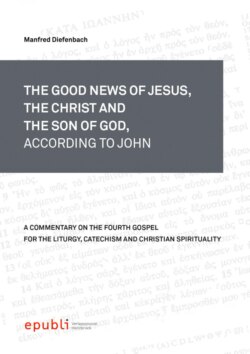Читать книгу THE GOOD NEWS OF JESUS, THE CHRIST AND THE SON OF GOD, ACCORDING TO JOHN - Manfred Diefenbach - Страница 16
На сайте Литреса книга снята с продажи.
Chapter 6
ОглавлениеAfter Jesus’ multiplication of the five loaves of bread and two fish for about 5,000 men (cf. 6:1–15) and His walking on the water (cf. vv. 16–21) as His (marvelous) deeds, the main topic of Jesus’ dialogical464 discourse of “the Bread of Life” (cf. vv. 25b–58) as a homily465 respectively as “a deeper lesson”466 with several quotations467 of the Hebrew Bible that we Christians called “Old Testament”, centres on verse 31c: “He gave them bread from Heaven to eat” and “I am the Bread of Life” (v. 35b). Chapter 6 focuses on the topic of Jesus as “the Bread of Life”.
The story of the multiplication of the bread and His feeding of 5,000 is like an overture of the sixth chapter. The multiplication of the loaves is structured with the help of the phrase “after this” in verse 1a and the preposition “then” in verses 5a, 11a, 13a, 14a, 15a.
The reflection about Jesus’ saying in verse 31 which is in the form of a dialogue between the Jew Jesus and “the Jewish people” is structured with the help of both
- “I am the Bread of Life” in verses 35b and 48;
- the introductory phrase “amen, amen I said to them” in verses 26b, 32b, 47a, 53b.
In the midst of the (Eucharistic) discourse, somebody – “the Jews” (vv. 41a, 52a) and some disciples of Jesus (cf. vv. 60–61, 64, 66) – intervene and contradict Jesus’ self-revelation468. Step by step, the Fourth Evangelist meditates the sense of this sentence of Jesus as “the Bread of Life” and “the giver of the bread” like a new Moses in six steps469:
- First dialogue between the crowd and Jesus (vv. 25b–27)
- Second dialogue between the crowd and Jesus (vv. 28–29)
- Third dialogue between the crowd and Jesus (vv. 30–33)
- Fourth dialogue between the crowd and Jesus (vv. 34–40)
- Fifth dialogue between “the Jews” and Jesus (vv. 41–51)
- Jesus’ Eucharistic Discourse (6th) as a monologue470 (vv. 52–58/59)
After the discourse about Jesus as the (sacramental) “Bread of (eternal) Life” (cf. vv. 25b–58/59) and as the divine “Son of Man”, the verses 60–71 resume the murmuring criticism of verses 41a, 43b and 52a to describe a mounting crisis of faith of His disciples. His Eucharistic discourse is the source of division and disbelief of His disciples.
“HERE is a passage … with tragedy, for in it is the beginning of the end. There was a time when men came to Jesus in large numbers” (cf. 2:23; 4:1–3, 39, 45). “Already John launches us on the last act of the tragedy. It is circumstances like these which reveal men’s hearts and show them in their true colours. In these circumstances there were three different attitudes to Jesus:
(i) There was defection. Some turned back and walked with him no more. They drifted away for various reasons. […]
(ii) There was deterioration. It is in Judas above all that we see this. Jesus must have seen in him a man whom he could use for his purposes.” […] (cf. vv. 70–71)
(iii) “There was determination. This is John’s version of Peter’s great confession at Caesarea Philippi (Mark 8: 27; Matthew 16: 13; Luke 9: 18”471; John 6:68–69)
